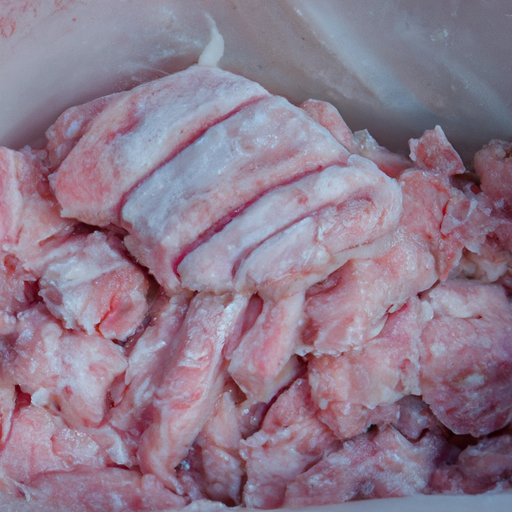
I. Introduction
Accidentally thawing meat at room temperature can be a frustrating mistake to make, especially if you’re unsure whether it’s safe to refreeze the meat. However, it’s important to address this issue to avoid potential health risks associated with consuming improperly thawed or refrozen meat. In this article, we’ll cover why refreezing meat that has been thawed at room temperature is unsafe, guidelines for safely thawing and refreezing meat, and tips for properly thawing and refreezing meat safely.
II. The Dangers of Refreezing Meat Thawed at Room Temperature: What You Need to Know
Refreezing meat that has been thawed at room temperature is unsafe due to the growth of harmful bacteria and the potential risk of foodborne illness. When meat is thawed at room temperature, it enters the “danger zone” temperature range of 40-140 °F, where bacteria can multiply rapidly. This bacteria growth can occur even if the meat doesn’t appear to be spoiled or have a foul odor.
The USDA recommends that meat should be thawed in a refrigerator at a temperature of 40 °F or below, in cold water, or in a microwave. Once meat is thawed, it should be cooked immediately or refrigerated and used within a few days. Refreezing meat that has been thawed at room temperature can increase the risk of foodborne illness due to the increased levels of bacteria that have grown during the initial thaw.
III. 8 Tips for Properly Thawing and Refreezing Meat Safely
It’s important to take steps to properly thaw meat to help prevent the need for refreezing in the first place and avoid food safety risks. Here are eight tips for safely thawing and refreezing meat:
- Thaw meat in a refrigerator at a temperature of 40 °F or below, in cold water, or in a microwave according to USDA guidelines.
- Avoid thawing meat at room temperature. If you must thaw meat quickly, use the cold water or microwave methods.
- Store thawed meat properly in a sealed container or bag in the refrigerator and use within a few days.
- Label thawed meat with the date it was thawed to ensure it’s used within a safe timeframe.
- Only refreeze meat that has been thawed properly in the refrigerator or cold water. Meat that has been thawed at room temperature should not be refrozen.
- Take steps to prevent the need for refreezing by portioning meat into smaller sizes before freezing to make it easier to thaw only what you need.
- Ensure that the freezer is at 0 °F or below to prevent the growth of bacteria in the meat.
- Don’t refreeze meat once it has been cooked.
IV. The Science Behind Why You Should Never Refreeze Meat Thawed at Room Temperature
Microbiological aspects of bacterial growth in thawed meat require specific conditions that are easily met by meat left at room temperature. Foods that are stored at temperatures between 40-140 °F have always been particularly prone to bacterial growth, and unsanitary conditions allow bacteria and other pathogens to spread, especially if the food has a high moisture content or is left out for too long. At such temperatures, bacteria can double in numbers in as little time as 20 minutes in some cases.
Meat contains moisture, a neutral pH, and nutrients that make it ideal for bacterial growth, with many bacteria having what experts call a psychrotrophic nature, meaning they grow best at temperatures near to freezing. When meat is left in unsanitary conditions at a higher temperature, the bacteria will grow at a fast pace even when the food is later refrozen.
V. How to Avoid Wasting Meat: The Dos and Don’ts of Refreezing Thawed Meat
Refreezing meat can lead to dryness, decreased quality, and flavor loss. Therefore, it’s important to avoid waste and preserve quality when handling thawed meat. Here are some tips on how to avoid unnecessary thawing and refreezing:
- Use thawed meat within a 2-day period to ensure optimal quality and freshness.
- Properly store thawed meat in a sealed container or bag in the refrigerator.
- Avoid thawing meat in the microwave unless it will be used immediately. Microwaving can cause the meat to cook slightly, leading to decreased quality after refreezing.
- Portion meat into small sizes before freezing to eliminate the need for refreezing portions.
- Only thaw and refreeze meat as needed. Refreezing meat multiple times can lead to a decrease in quality and increase the risk of foodborne illness.
- Discard meat that has been left at room temperature for longer than two hours.
- Avoid placing warm meat directly in the freezer. Allow it to cool to room temperature first to prevent the temperature rise in the freezer.
- Never refreeze meat that has been thawed at room temperature.
VI. The Consequences of Ignoring Food Safety: Refreezing Meat at Room Temperature
Consuming improperly thawed or refrozen meat can lead to potential health consequences, including foodborne illness. The population group most vulnerable to such illnesses are those with weakened immune systems, including children, pregnant women, older adults, and those suffering from chronic illnesses. Improper handling of meat can also have legal and financial implications for food service businesses and home cooks. Failing to adhere to food safety regulations can lead to lawsuits, fines, and enforcement actions.
VII. Conclusion
In conclusion, it’s important to prioritize safe food handling and preparation when thawing and refreezing meat. Refreezing meat once it has been left at room temperature can increase the risk of foodborne illness and lead to reduced quality and flavor. To avoid waste and ensure optimal safety and taste, use safe thawing and refreezing techniques, and avoid refreezing meat that has been left at room temperature. By following simple guidelines, every home cook can prevent foodborne illnesses and save money, while making sure everybody at the dinner table stays healthy and happy.





